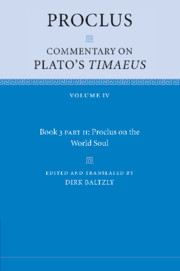V - The Soul’s Form
Published online by Cambridge University Press: 30 June 2022
Summary
Psychic linearity, Tim. 36b6–c1
So then, he divided this entire composite in two lengthwise strips, affixing each to the other, middle to middle, like an X. (Tim. 36b6–c1)
Mathematical interpretation
First it is necessary to speak about this in a mathematical fashion, determining what sort of shape the soul has. Then it is necessary to introduce the consideration of the facts so that we may provide ourselves with the receptivity to be well directed by our imaginative capacity (phantasia) toward a knowledgeable apprehension (epistêmonikê antilêpsis) concerning what is said here.
We must therefore conceive all these numbers as having been inscribed along a monochord, just as those who study harmonics customarily do. Let it have these numbers inscribed through its whole depth, and let the monochord be divided lengthwise. Now surely all the ratios will be present in each of the pieces. For if the division had been made across the width, then it would necessarily have been the case that some of the numbers would be found here, while others were there. But since the strips were taken lengthwise, all the numbers would be in all the strips, and the same numbers will be present in each of the portions. For this is obvious: that it is not the same thing to divide the length and to divide lengthwise. The latter signifies that the strip runs through the whole length, while the former implies that someone cuts the length. So therefore let the monochord be divided lengthwise in this manner and let these two lengthwise strips be affixed to one another at the point midway along the strips – not entirely right angles (for the circles will not be at right angles) – and so that the straight lines have been thus bent around so that the end points have again been joined. Now surely two circles come into being, and these have come to be in such a way that one is on the inside and the other is on the outside, and they are at an angle to one another. Now one of these is called the circle of the Same and the other is the circle of the Different. The one corresponds to the equator while the other corresponds to the circle of the ecliptic.
- Type
- Chapter
- Information
- Proclus: Commentary on Plato’s Timaeus Volume 4: Book 3, Part 2: Proclus on the World Soul , pp. 221 - 245Publisher: Cambridge University PressPrint publication year: 2009



